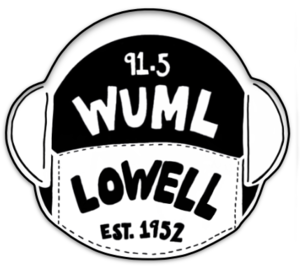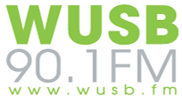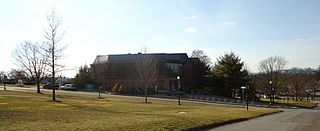
Bucknell University is a private liberal-arts college in Lewisburg, Pennsylvania, United States. Founded in 1846 as the University at Lewisburg, it now consists of the College of Arts and Sciences, the Freeman College of Management, and the College of Engineering. It offers 65 majors and 70 minors in the sciences and humanities. Located just south of Lewisburg, the 445-acre (1.80 km2) campus rises above the West Branch of the Susquehanna River.

WUML is a non-commercial college radio station licensed to Lowell, Massachusetts, United States. The station is owned by the University of Massachusetts Lowell. The transmitter is atop Fox Hall on Pawtucket Street in Lowell.

KXUA is a student-run college radio station broadcasting an eclectic radio format. Licensed to Fayetteville, Arkansas, it serves the university campus and surrounding community. The university also owns the more powerful 91.3 KUAF, which broadcasts news, information and classical music as an NPR member station.

KUOM – branded Radio K - Real College Radio – is a daytime-only, non-commercial, college radio station licensed to Minneapolis, Minnesota. Owned by the University of Minnesota, Twin Cities, the station is operated by students and faculty. It mainly airs alternative rock with other genres of music. The studios are in Rarig Center on the University of Minnesota campus.

WUSB is a non-commercial radio station licensed by the Federal Communications Commission (FCC) to Stony Brook, New York. The station is owned by the State University of New York, with studios located on the second floor of Stony Brook University's West Side Dining facility, and its transmitter is located in Farmingville, New York. WUSB is a free-form radio station, staffed by more than 150 volunteers who devote their time and energy for the love of music and free-form radio. The station is partially listener-supported.
WRPI is a non-commercial free-format college radio station run entirely by students attending Rensselaer Polytechnic Institute and staffed by community members and students. WRPI broadcasts every day with an effective radiated power of 10,000 watts, serving listeners in Albany, eastern New York, western Massachusetts, Vermont, and online via live streaming. The studios are located in the basement of the Darrin Communications Center and the FM signal is broadcast from North Greenbush. Programming includes a wide range of music, cultural and public affairs programs, live bands, special events, and sports simulcasts, particularly of RPI hockey, football, and baseball. WRPI has a large record library dating to the origins of the station, estimated at 43,800 albums, and a large CD library, dating to the start of the medium.
WCBN-FM is the student-run radio station of the University of Michigan. Its format is primarily freeform. It broadcasts at 88.3 MHz FM in Ann Arbor, Michigan.

CJUM-FM is a volunteer-driven campus radio station in Winnipeg, Manitoba, Canada, based at the University of Manitoba and transmits with 1,200 watts from an antenna located at Portage and Main in downtown Winnipeg.
WVCR-FM(88.3 The Saint) is a variety hits radio station located in Loudonville, New York, owned by Siena College, and primarily staffed by students from the college. The station broadcasts on 88.3 MHz at an effective radiated power of 2,800 watts from the Helderberg Mountains in the Town of New Scotland. In addition to simulcast programming at www.wvcr.com, WVCR is perhaps the only non-commercial licensee to emulate the variety hits format made popular by the Jack FM approach in the Capital Region. The format is very popular in the region with a very diverse selection from classic 1960s hits to current hits of today—something of a 2,800 Watt iPod for Baby Boomers.
KSPC is a non-commercial college and community radio station based in Claremont, California, broadcasting at 88.7 MHz on the FM band and streaming online. It was founded in 1956 as a Pomona College student organization and later expanded to the other Claremont Colleges (7Cs). KSPC is funded by the Associated Students of Pomona College and other 7C student associations.

WRUC is an independent educational college radio station, owned and operated by Union College in Schenectady, New York. The station transmits with an effective radiated power of 100 watts, covering an approximate 12-mile radius, though reception in fringe areas depends on the terrain. WRUC also streams its programming on Internet radio. The station's offices and studios are located in the Reamer Campus Center on the Union College campus.
WONU is a non-commercial radio station licensed to Kankakee, Illinois, United States, and serving the region south of the Chicago metropolitan area. It is a non-profit, listener-supported station owned and operated by Olivet Nazarene University, which is located in Bourbonnais, Illinois. It airs a Christian Adult Contemporary radio format.
KHPE is a commercial radio station in Albany, Oregon, serving the Willamette Valley. It is owned by Extra Mile Media and airs a Christian Contemporary radio format. For much of November and December, the station switches to Christmas music, performed by both secular and Christian music artists. The studios are on Santiam Highway SE.

WDIY is a community-run public radio station licensed to Allentown, Pennsylvania with studios in Bethlehem and a transmitter atop South Mountain. A member of NPR, the station serves the Lehigh Valley region of eastern Pennsylvania, as well as parts of western New Jersey.

WQSU is a non-commercial, college FM radio station that is licensed to serve Selinsgrove, Pennsylvania. The station is owned and operated by Susquehanna University and is staffed by students and faculty of the university as well as community volunteers.
WPRK 91.5 FM is a non-commercial college radio station located in Winter Park, Florida, United States. It is owned and operated by Rollins College. Its signal is audible in most of the Orlando metropolitan area. WPRK features programming from nearly every mainstream and non-mainstream music genre.

KOHL is a student-run college radio station licensed to and owned by Ohlone Community College District in Fremont, California. The station broadcasts a Contemporary Hit Radio format.
WKOK is a commercial radio station in Sunbury, Pennsylvania. It is owned by Sunbury Broadcasting Corporation and it broadcasts a combination News, Talk and Sports radio format. The radio studios and transmitter are on County Line Road in Selinsgrove.

WRDL is a non-commercial educational radio station licensed to Ashland, Ohio. The station serves the North-Central Ohio area and is the only radio station located within the city limits of Ashland. The station is owned and operated by Ashland University. Its studios are located in the Center for The Arts building. The transmitter and its antenna are located in the top floor of the library.

7th Street is a downtown street in Lewisburg, Pennsylvania, United States. It runs for around 1.06 miles (1.71 km), from North 10th Street in the northwest to River Road in the southeast. North of its intersection with Market Street, it is named North 7th Street; south of it, it is South 7th Street. From the West Branch Susquehanna River inland, Market Street's cross streets are numbered 2 through 8, with Front Street replacing what was originally 1st Street. Lewisburg's street layout was designed by Ludwig Derr in 1785, and is believed to have been inspired by that of Philadelphia.











